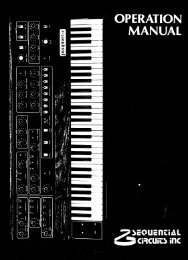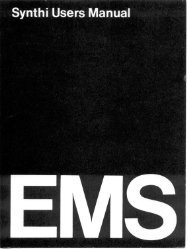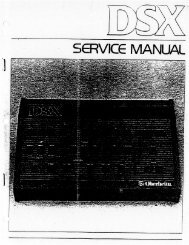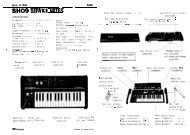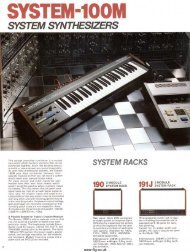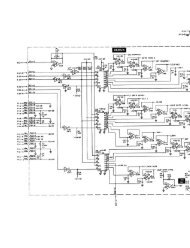ARP2600 - Fundamentals of Music Technology - Cyborgstudio.com
ARP2600 - Fundamentals of Music Technology - Cyborgstudio.com
ARP2600 - Fundamentals of Music Technology - Cyborgstudio.com
You also want an ePaper? Increase the reach of your titles
YUMPU automatically turns print PDFs into web optimized ePapers that Google loves.
068 - SECTION EIGHT: THE VCAEXPERIMENTS FOR SECTION EIGHT1. Connect the VCF to the VCA. Demonstrate that this is a redundant patch. Use the lowest initial gainsetting to ‘gate’ the in<strong>com</strong>ing sound and use an EG to open and close the VCA.2. Connect VCO-3’s saw output to one <strong>of</strong> the audio inputs on the VCA. Raise its attenuation slider. Trymoving the initial gain slider to determine its effect on the sound.3. While conducting experiment #2, connect a sine wave from VCO-2 in LF mode to the linear controlinput. Raise its attenuation slider. Try changing the attenuation <strong>of</strong> both the in<strong>com</strong>ing audiosignal and the in<strong>com</strong>ing control voltage. After observing the effects <strong>of</strong> these settings, try increasingthe initial gain setting, and notice how the effect <strong>of</strong> the in<strong>com</strong>ing control voltage isdecreased. What effect is being created here? CD track 44 Try increasing the rate and depth toproduce sidebands. CD track 454. Try experiment #3 again, but this time, use the exponential control input. What sounds differentabout the output now? Why is there almost no change in amplitude? Try using VCO-2’s pulseoutput instead <strong>of</strong> the sine output. Why is this more effective?5. Patch VCO-3’s saw wave to one <strong>of</strong> the audio inputs <strong>of</strong> the VCA, and this time, use the ADSRgenerator patched to the linear control input (redundant patch) to control the VCA. Repeat thisexperiment, and this time patch the AR generator to the exponential response circuit. What isdifferent about this sound? CD track 436. Create a patch in which VCO-2 and VCO-3’s saw waves are fed into the VCF. The VCF’s Fc shouldbe controlled by the ADSR generator. The VCF’s output should be fed to the VCA. Control theVCA using the AR generator. Notice how effective this patch is. Note which settings are themost beneficial on the AR generator regardless <strong>of</strong> the settings <strong>of</strong> the ADSR generator. Nowrepeat this experiment, and control the VCA using the ADSR generator and control the VCFusing the AR generator. Which <strong>of</strong> the two configurations do you prefer? CD track 467. Connect two different VCOs tuned to different pitches to each <strong>of</strong> the VCA’s audio inputs, anddemonstrate its ability as a mixer.8. Compare the VCF’s gating to the VCA’s gating by patching the saw wave from VCO-2 to the audioinputs <strong>of</strong> each, and bring up the outputs <strong>of</strong> the VCF and the VCA in turn at the mixer. Start withthe VCF, open the filter <strong>com</strong>pletely, with no resonance. Sweep the Fc down until the filter isclosed. Notice that as the sound got s<strong>of</strong>ter, the timbre <strong>of</strong> the sound changed as well. Next, listento the VCA perform the same gating task by starting with the INITIAL GAIN set full open andthen sweep it down until it is fully closed. Notice that the timbre <strong>of</strong> the sound remains constantthroughout the sweep, and only the amplitude or volume <strong>of</strong> the sound changes. CD track 429. Note what is normalled to each input <strong>of</strong> the VCA. Notice where the VCA’s output is normalled.




